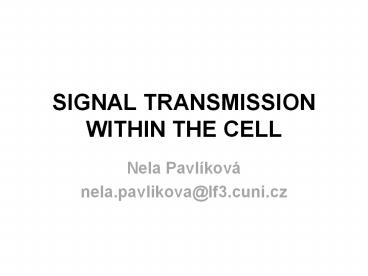SIGNAL TRANSMISSION WITHIN THE CELL - PowerPoint PPT Presentation
1 / 27
Title:
SIGNAL TRANSMISSION WITHIN THE CELL
Description:
SIGNAL TRANSMISSION WITHIN THE CELL Nela Pavl kov nela.pavlikova_at_lf3.cuni.cz G-PROTEIN COUPLED RECEPTOR - 7 transmembrane segments G-protein heterotrimer, composed ... – PowerPoint PPT presentation
Number of Views:70
Avg rating:3.0/5.0
Title: SIGNAL TRANSMISSION WITHIN THE CELL
1
SIGNAL TRANSMISSION WITHIN THE CELL
- Nela Pavlíková
- nela.pavlikova_at_lf3.cuni.cz
2
G-PROTEIN COUPLED RECEPTOR
- 7 transmembrane segments
3
G-protein
- heterotrimer, composed of 3 different subunits
a, b, g - a subunit 33-55kD
- - binding place for GDP / GTP
- - intrinsic hydrolytic activity for GTP (it
binds GTP activation ? hydrolyzing of
GTP to GDP deactivation) - - in deactivated state - it has bound GDP
molecule - - it is associated with Gb/g complex
- b subunit 35kD
- g subunit 15kD
- - creates Gb/g complex
- mammals 20 different G proteins (each contains
unique Ga subunit one of 5 b
subunits and one of 12 g subunits)
4
(No Transcript)
5
Gai
Gas
Gaq
6
Gas
- stimulates adenylyl cyclase ? synthesis of cAMP ?
activation of protein kinase A (PAK) ?
phosphorylation of nearby substrates - cholera toxin it keeps Gas permanently activated
? ?cAMP - Gai
- after activation it inhibits adenylyl cyclase ?
?cAMP - pertussis toxin Gai subunit unable to release
GDP ? incapable of activation ? cannot inhibit
adenylyl cyclase - cAMP is involved in regulation of many ion
channels
7
Gaq
- not influenced by cholera toxin nor pertussis
toxin - phospholipase Cb ? inositol-3-phosphate (IP3) ?
?Ca2 in cell ? CaMKII - ? diacylglycerol (DAG) ? protein kinase
C - both pathways lead to phosphorylation of nearby
proteins
8
(No Transcript)
9
Gat
- transducin
- sensitive to pertussis toxin ? incapability to
release GDP ? inhibition of signalization - Vision t1 black-and -white
- t2 colors
- occurrence retina, some stem cells
- effector phosphodiesterase-6 (PDE6)
- ? degradation of cGMP
10
Gao
- other
- effectors not known
- sensitive to pertussis toxin ? incapability to
release GDP ? inhibition of signalization - occurrence neural and endocrine tissues, mitotic
spindle - early development effect of serotonin on neuron
migration
11
Ga12/13
- activation of REF (Rho guanine-nucleotide
exchange factors) ? activation of Rho proteins - occurrence ubiquitous
12
(No Transcript)
13
RECEPTOR TYROSINE KINASE
14
RECEPTOR TYROSINE KINASE
- growth factors, cytokines, hormones
- 17 subfamilies of receptors
- dimerization of receptors necessary (even
tetramers) - only one transmembrane segment (N-end
extracellular, C-end intracellular) - tyrosine phosphorylation creation of binding
domains for cytosolic signaling proteins ?
binding ? activation of signaling pathways - cytosolic signaling proteins e.g. Src,
phospholipase Cg, PI3-kinase - domains for binding on phosphorylated tyrosines
- SH2 domain (src), PTB domain (PI3-kinase)
15
RECEPTOR TYROSINE KINASE
- endocytosis of activated receptor
- destruction of receptor in lysosome ? binding of
ubiquitin molecule on kinase - endocytosed receptor signalization e.g. NGF
16
(No Transcript)
17
RECEPTOR TYROSINE KINASE
- Ras, Rho - monomeric GTPases
- - anchored in the inner membrane
- - a part of receptor tyrosine kinase signaling
pathway - - activation GEF (guanine nucleotide exchange
factor) - - inhibition GAP (GTPase activating factor)
- ?
- resistance ? cancer
- Ras ? MAP kinase ? signalization into nucleus (?
e.g. cell proliferation) - Rho ? connect RTK with cytoskeleton (? cell
shape, motility, adhesion)
18
RECEPTOR TYROSINE KINASE
19
(No Transcript)
20
RECEPTOR TYROSINE KINASE
- PI-3 kinase - Akt
21
RECEPTORS ASOCIATED WITH TYROSENE KINASE
- JAK-STAT
22
RECEPTOR SERINE/THREONINE KINASE
- ligand e.g. TGF-b
- SmaDs ? regulatory protein
- endocytosis ? activation
- ? degradation
23
NUCLEAR RECEPTORS
- their ligands can cross the cytoplasmic membrane
on their own - transcription factors (in activated form they
start transcription of target genes) - nuclear receptors activated by ligand vs.
orphan receptors - type I receptor in cytosol ? ligand binding ?
homodimerization - ? transport into nucleus ? binding on
response element part of DNA ? start of
transcription - type II receptor as heterodimer with RXR (and
some corepressors) bound in nucleus on
response element ? ligand into nucleus?
binds to receptor ? dissociation of
corepressors ? start of transcription
24
(No Transcript)
25
(No Transcript)
26
(No Transcript)
27
answer on the question from the last
seminarsynthesis of thyroid hormones































